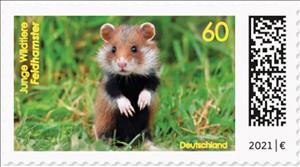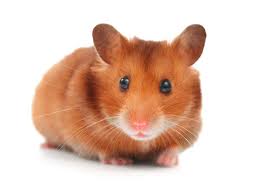Stamp: European Hamster (Cricetus cricetus) (Germany, Federal Republic 2021)
European Hamster (Cricetus cricetus) (Germany, Federal Republic 2021)
10 June (Germany, Federal Republic ) within release Baby Animals 2021 goes into circulation Stamp European Hamster (Cricetus cricetus) face value 60 Euro cent
| Stamp European Hamster (Cricetus cricetus) in catalogues | |
|---|---|
| Michel: | Mi: DE 3608 |
Stamp is horizontal format.
Also in the issue Baby Animals 2021:
- Stamp - Alpine Ibex (Capra ibex) face value 95;
- Mini Sheet - Alpine Ibex (Capra ibex) face value 10*95;
- Mini Sheet - European Hamster (Cricetus cricetus) face value 10*60;
- Stamp - European Hamster (Cricetus cricetus) face value 60;
Stamp European Hamster (Cricetus cricetus) it reflects the thematic directions:
Animals are multicellular, eukaryotic organisms of the kingdom Animalia (also called Metazoa). All animals are motile, meaning they can move spontaneously and independently, at some point in their lives. Their body plan eventually becomes fixed as they develop, although some undergo a process of metamorphosis later on in their lives. All animals are heterotrophs: they must ingest other organisms or their products for sustenance.
Hamsters are rodents (order Rodentia) belonging to the subfamily Cricetinae, which contains 19 species classified in seven genera.They have become established as popular small pets The best-known species of hamster is the golden or Syrian hamster (Mesocricetus auratus), which is the type most commonly kept as a pet. Other hamster species commonly kept as pets are the three species of dwarf hamster, Campbell's dwarf hamster (Phodopus campbelli), the winter white dwarf hamster (Phodopus sungorus) and the Roborovski hamster (Phodopus roborovskii).
Mammals are any vertebrates within the class Mammalia (/məˈmeɪli.ə/ from Latin mamma "breast"), a clade of endothermic amniotes distinguished from reptiles (including birds) by the possession of a neocortex (a region of the brain), hair, three middle ear bones and mammary glands. All female mammals nurse their young with milk, secreted from the mammary glands. Mammals include the largest animals on the planet, the great whales. The basic body type is a terrestrial quadruped, but some mammals are adapted for life at sea, in the air, in trees, underground or on two legs. The largest group of mammals, the placentals, have a placenta, which enables the feeding of the fetus during gestation. Mammals range in size from the 30–40 mm (1.2–1.6 in) bumblebee bat to the 30-meter (98 ft) blue whale. With the exception of the five species of monotreme (egg-laying mammals), all modern mammals give birth to live young. Most mammals, including the six most species-rich orders, belong to the placental group. The largest orders are the rodents, bats and Soricomorpha (shrews and allies). The next three biggest orders, depending on the biological classification scheme used, are the Primates (apes and monkeys), the Cetartiodactyla (whales and even-toed ungulates), and the Carnivora (cats, dogs, seals, and allies).



